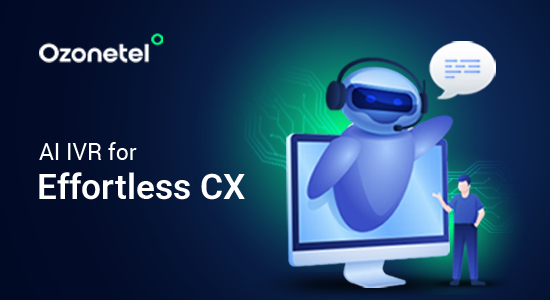- Resources
- What is Digital Experience? Everything You Need to Know
What is Digital Experience? Everything You Need to Know

A good digital experience doesn’t only mean having a digital presence but it combines every digital touchpoint through which customers interact with your brand. And why only customers? A seamless, intuitive, and engaging digital experience also helps boost employee productivity and enhance your brand’s presence.
But, how do you ensure that the digital experiences your team offers stays with the customer long after their interaction? You can do this by building a customer experience strategy that satisfies them at every digital interaction they have with your brand. This translates directly into increased customer lifetime value and decreased customer acquisition expenses, resulting in a greater brand value and a loyal customer base.
In other words, digital customer experiences can either build loyal customers or those who would never buy from your company. Read along to know more!
In this article, we will explore:
- 1. What is Digital Experience?
- 2. Importance of Digital Experience for Your Businesses
- 3. Digital Experience Vs Digital Customer Experience
- 4. Best Practices for Delivering Excellent Digital Customer Experience
- 5. What Tools are Required to Improve Digital Experience?
- 6.How is Digital Experience Related to Other Experiences?
- 7. How Ozonetel Boosts Digital Experience Monitoring
Customer Lifetime Value Meaning
Customer Lifetime Value (CLV) measures the total profit your company can expect to generate from an average customer throughout their entire relationship with you.
Looking for the best AI call center software? You’re in the right place. It’s no secret that AI is changing how businesses talk to their customers. But with so many options out there, finding the right one can be tricky.
Don’t worry, though – we’ve got you covered. In this article, we’ll break down the top AI call center tools. Whether you’re running a small business or managing a big customer service team, we’ll help you find software that makes your life easier and your customers happier. Let’s get started!
What is Digital Experience?
Digital experience refers to the aspects of your customer experience (CX) journey that involve online platforms such as mobile and desktop, as well as digitally mediated experiences such as owned apps and social media content. It also applies to technologically connected settings, such as IoT and voice-activated gadgets. Ultimately, wherever your clients interact with your brand over the internet, it is a digital experience.
Now, let’s look at the important elements of a strong digital client experience:
- Success: Did the customer do their task and meet their goal?
- Emotion: Did they leave the interaction feeling good?
- Effort: Was the entire experience smooth and easy?
Basically, digital experience refers to the interactions customers have with a brand via digital platforms such as websites, social media, smartphones, and email. It can be considered a subcategory of customer experience that focuses solely on digital interactions and touchpoints between a brand and its customers.
Importance of Digital Experience for Your Businesses
As digital experience grows more prominent across all industries, customers’ behaviors and expectations evolve over time — and organizations must be adaptable enough to satisfy those expectations. This is where digital experience helps businesses in ways like:
Measuring the ROI of Digital Experience
Investing in your digital experience is more than just keeping up with trends; it’s also about increasing your profits. Here’s how to calculate the return on your investment:
- Increased conversion rates: A user-friendly digital experience can greatly increase conversion rates. Track these figures before and after making changes to see how they affect the results.
- Customer Lifetime Value: Satisfied customers stick around longer and spend more. Monitor how your digital experience enhancements affect customer retention and spending habits.
- Reduced Support Costs: You may lessen the workload of your customer support crew by providing better self-service choices and intuitive interfaces. This translates into cost savings.
- Brand Perception: Use social listening tools and consumer surveys to determine how your digital experience influences your brand’s reputation.
Meeting Customers’ Expectations
The days of having just a desktop website are over. Customers now expect smooth interactions across several devices. Whether they’re on their phone, tablet, or computer, they expect a consistent and user-friendly experience. If you cannot provide, customers will most likely search elsewhere.
Improving Customer Service
As your company expands, so does the demand on your customer support personnel. Chatbots and automated surveys are examples of digital solutions that can assist alleviate the workload. Plus, they also help your tema respond quickly to consumer inquiries, increasing overall satisfaction.
Human-Centric Approach
In a growing digital environment, retaining a personal touch is critical for developing meaningful relationships with clients. And a successful digital experience strategy embodies this human-centric approach by providing individualized information, tailored recommendations, and timely customer service.
Businesses that see each interaction as an opportunity to engage and delight users can build stronger connections, inspire brand loyalty, and differentiate themselves from competition.
Leveraging Customer Insights
Each click, scroll, and interaction on your digital platforms generates significant information. Using this data, you can better personalize your marketing efforts and tailor your offers to fit the demands of your customers.
Boost in Customer Loyalty
A pleasant digital experience can convert one-time purchasers into loyal customers. Here’s why.
- Trust Building: A seamless, dependable digital experience fosters trust in your brand. When clients know they won’t have to repeat their problems on a different digital medium, they will be more inclined to stick with your brand.
- Personalization: Using consumer data to create individualized experiences helps your customers feel appreciated and understood.
- Convenience: Make it easy for people to interact with your brand online, and they are more likely to choose you over competitors.
- Problem Resolution: Quick, effective problem-solving via digital channels can transform potentially bad encounters into good ones, hence increasing loyalty.
Reduced Customer Churn
Customer churn (i.e., how many consumers cease using your products or services and switch to a competing brand) is something that all brands want to reduce whenever possible. Naturally, if your digital experience strategy aims to improve customer retention and loyalty, it will reduce your turnover rate as well. This means you won’t be held hostage to constantly looking for new customers—and paying hefty customer acquisition fees to do so—and can instead focus more time and energy on maintaining existing client relationships.
Digital Experience Vs Digital Customer Experience
While the terms Digital Experience (DX) and Digital Customer Experience (DCX) are often used interchangeably, they have distinct meanings. Digital Experience encompasses the overall interaction an individual has with a digital environment, including websites, mobile apps, and other digital platforms.
On the other hand, Digital Customer Experience specifically refers to the interactions a customer has with a brand’s digital touchpoints, emphasizing customer satisfaction and engagement. Here are the differences in a little more detail:
| Aspect | Digital Experience (DX) | Digital Customer Experience (DCX) |
|---|---|---|
| Definition | Overall interaction with digital environments | Interaction a customer has with a brand’s digital touchpoints |
| Scope | Includes all users (employees, partners, customers) | Focuses specifically on customers |
| Focus | Usability, functionality, and performance of digital platforms | Customer satisfaction, engagement, and loyalty |
| Examples | Intranet systems, enterprise applications, digital workspaces | E-commerce websites, customer service apps |
| Measurement Metrics | User adoption rates, system performance, user feedback | Customer satisfaction scores, Net Promoter Score (NPS), customer retention rates |
Best Practices for Delivering Excellent Digital Customer Experience
Improving your digital experience is not a simple project. Even with good intentions, many teams complicate their CX or provide insufficient customization. Here are five recommended practices that will help you satisfy your consumers at scale:
Create Buyer Personas
True innovation and personalization in digital consumer experiences stem from a thorough understanding of your customers and target demographic. Creating data-driven client or user personas is the first step. These personas should provide a thorough understanding of your clients’ pain concerns, demographics, purchasing habits, and motives.
Buyer personas will help you discover crucial touchpoints in the digital customer journey that may require adjustments or additions. They will also assist you in creating a comprehensive customer journey map, which will provide a visual depiction of how personas interact with digital experiences. Analyzing rivals’ experiences and services can provide useful information for measuring and improving your CX approach.
Create an Omnichannel Experience
To genuinely offer a seamless and consistent omnichannel experience, you must understand your customer’s journey across all touchpoints. The fundamental goal is to ensure that your customers have a consistent experience whether they interact with your brand online, offline, or across several digital channels.
This technique includes:
- Integration: Ensure that your systems, processes, and teams are all integrated to enable seamless transitions between channels. This includes customer service, sales, and marketing operations.
- • Consistency: Coordinate your brand’s messaging and user interface across all channels. This will help to develop a strong brand identity and guarantee that customers know exactly what to anticipate.
In other words, no matter where your clients encounter your brand, they should always feel fully involved in the brand experience. Any disconnect along the route could lead to trouble.
Leverage Personalization
Whether you have ten or tens of thousands of consumers, it is your responsibility to provide each one with a personalized experience. Given that 83% of customers are prepared to provide personal information if it results in a better customer experience, it would be foolish not to seize every bit of data and use it to your benefit.
However, keep in mind that customization is no longer only an optional feature. Forty-eight percent—nearly half—of consumers have indicated they’ve left a website because they thought it was “poorly curated” for their needs.
Including these small touches across the digital customer experience demonstrates that you genuinely care about your consumers’ wishes and needs. And when done correctly, it can be extremely beneficial—far beyond simply increasing customer satisfaction.
Implement AI Tools
Artificial intelligence (AI) is rapidly becoming a critical component in digitizing the customer experience. AI technologies enable businesses to provide new self-service capabilities and experiences to customers via generative chatbots and assistants. AI in call centers is an excellent illustration of how these technologies can improve efficiency and customer happiness.
However, it is critical to use these remedies with prudence. Overuse of AI may result in unanticipated exceptions and failures, adding friction rather than alleviating it. Iterative operations, high-volume processes, data transfers, and language analysis are ideally suited for AI-powered customer service digitization.
Close the Loop
Closed-loop feedback refers to the practice of following up with clients who have provided feedback regarding an unpleasant experience. Connecting with these consumers to resolve the issue can be a great method to transform negative experiences into positive ones while also preserving and strengthening customer connections.
Knowing which clients to prioritize is critical in closed-loop feedback because you won’t have the time or resources to do it for everyone. So, create a set of criteria for high-value clients with whom you will utilize this method, and use ticketing software to ensure that negative feedback from this portion of your customer base triggers an alert to the individuals who need to take action.
Conduct User Testing
User testing is another method for determining how much customers appreciate using your digital assets. In this setting, a restricted group of clients is asked to test your product. They then give input on specific parts of the user experience. This allows you to improve your website or app before releasing it to the rest of your consumer base.
While there are other sorts of user tests, the most common is usability testing. Usability tests determine how easy it is to use and navigate your product. The participants are instructed to complete a basic assignment. Then they are assessed on their ability to complete it. This demonstrates to your development team how user-friendly your website or application is.
What Tools are Required to Improve Digital Experience?
It might be tough to determine whether your digital customer experience is operating at maximum capacity. Fortunately, there are numerous excellent tools available that may provide useful data and insights into both what you’re doing well and what you could do better.
Behavioral analytics
Understanding what makes your consumers tick—including why they move about the way they do—when they visit your website can help you design your digital customer experience in a way that directly answers their needs. Tools like Google Analytics, for example, provide a range of behavioral insights, such as how long users stay on your website (session duration) and how many leave the page without making a purchase or completing a transaction.
A/B testing
Simply said, A/B testing is a method for testing and measuring the performance or effectiveness of several variations of your website for different clients, often in order to determine which variations increase conversion or engagement. Tools such as Google Optimize, Freshmarketer, and Optimizely allow you to assign a ‘control’ and a ‘variation’ of your testing settings so that you can compare which performed better after a defined period of time. It’s an excellent technique to check your assumptions with real-world user data before allocating resources and finances to modifications that don’t have the anticipated impact.
Marketing tools
Marketing automation services provide a comprehensive approach to your marketing activities, focusing on your website, CRM, emails, and lead nurturing programs—all of which work together to provide your users with the most delightful experience possible. It also saves a significant amount of manual labor.
You can specify rules for what occurs next to your defined audience using “triggers” on your digital experiences, such as forms, searches, link clicks, or surfing. Did they fill out a form? Then they may be engaged in an automated program that sends them a series of emails, each with useful content.
Heat mapping
Heat mapping is one of the most efficient means to understand how your clients react when they visit your website. Unfortunately, not all tools are made equally. Look for one that tracks your website visitors’ mouse movements, scrolling, clicks, and touches. Hotjar, Mouseflow, and Smartlook are all fantastic choices with both premium and free versions.
Analytics
A digital experience platform is the foundation of your digital experiences, but it requires more than just a robust system for content creation and presentation. You also need to understand what your readers are doing and why, as well as smart rules to automate a variety of operations.
Enter the analytical tools – these solutions watch your audience’s behavior, display search trends within your site and specified terms, and some may even allow you to automate the use of conversion tracking on specific sites based on your requirements.
CRM Tools
CRM enables businesses to optimize procedures, create customer relationships, boost sales, improve customer service, and boost profitability. It’s all about monitoring every client encounter to reduce churn at all costs. Furthermore, employing an effective CRM system will allow you to record this information once, giving additional agents interacting with this customer—whether or not they are working on the same issue—an advantage in offering a relevant and personalized customer care experience.
How is Digital Experience Related to Other Experiences?
Digital Experience (DX) integrates with other experience categories to provide a more comprehensive approach to consumer and employee satisfaction. It refers to all digital interactions a user has with a business, from website navigation to mobile app usage. Let’s look at how DX relates to and influences other organization experiences.
The Impact of DX on Customer Experience
Digital CX represents the best chance for consumer involvement, advocacy, acquisition, and retention. It is becoming increasingly crucial as preferences and expectations shift as a result of COVID-19.
And to satisfy this, the 5% of brands—that ranked in Customer Experience Index—altered their DCX strategy to fulfill core consumer needs. This led them to outperform rival businesses in terms of effectiveness and ease of creating pleasurable consumer experiences.
However, with so many touch points through which to deliver your product or service, it’s critical that you plan ahead of time how to properly integrate them all into a CX strategy. So, how do you create an effective digital CX strategy that boosts customer experience?
In practice, digital customer experience strategies are influenced by both data and human factors. The goal of digital CX is to provide customers with more options, more ease, and speed while preserving a human touch that makes customers feel appreciated. Furthermore, data helps you in accomplishing this by providing insight into how customers connect with your business, as well as why they do not do so at certain times or in specific ways.
The Role of Employee Experience (EX) in Delivering Great DX
Your employees are the foundation of your digital experience efforts; their satisfaction and engagement have a direct impact on the quality of DX delivered to customers. When your team members have access to effective digital tools and optimized processes, they can concentrate on providing excellent service.
Investing in user-friendly internal systems and providing extensive digital training enables your personnel to successfully explore and use digital platforms. This not only improves their work experience, but also allows them to better help consumers in digital surroundings. Employees who are happy are more inclined to go above and beyond to ensure that your clients have a great digital experience.
Optimizing Contact Center Experience (CCX) for Improved DX
Contact centers serve as an important link between digital and human interactions. By incorporating innovative digital solutions into your contact center operations, you may drastically improve the agent and customer experience.
To do this, you can implement omnichannel support solutions that ensure smooth transitions between digital platforms and human assistance. This guarantees that consumer data and context remain consistent across all touchpoints, resulting in more tailored and efficient engagements. Use AI-powered chatbots to quickly respond to basic questions, freeing up human agents to handle more difficult problems.
How Ozonetel Boosts Digital Experience Monitoring
DEM solutions let organizations optimize and personalize their digital products by tracking user interactions across several digital touchpoints, creating long-term customer connections and driving overall satisfaction.
If you’re looking for a means to improve your digital customer experience, Ozonetel’s CX Hub could be the solution! The platform is intended to provide enhanced experiences across all digital touchpoints in the client lifecycle. It also employs important capabilities like omnichannel routing, customer data and insights, chatbot automation, agent assistance features, and integrated analytics for interactions.
Final thoughts
By choosing the right AI-powered solution, companies can significantly improve customer satisfaction, reduce operational costs, and gain valuable insights into their service performance. And as you decide on the AI call center software to deploy in your organization, consider Ozonetel’s comprehensive suite of AI-powered tools.
Ozonetel offers a robust platform that integrates seamlessly with your existing systems, providing advanced features like intelligent routing, sentiment analysis, and real-time agent assistance. With its user-friendly interface and quick
Want to see what Ozonetel can do for your company? Sign up today for a free 7-day trial.
Prashanth Kancherla
Chief Operating Officer, Ozonetel Communications
Over the past decade, Prashanth has worked with 3000+ customer experience and contact center leaders...
Chief Operating Officer, Ozonetel Communications
Over the past decade, Prashanth has worked with 3000+ customer experience and contact center leaders to comprehensively understand the need for effective and efficient customer communications at every step of their journey with a brand. Deeply embedded in today’s CCaaS ecosystem, he has been instrumental in Ozonetel's growth and contributed in various roles including product management, sales, and solution architecture.
Frequently Asked Questions
The digital experience (DX) is the collection of responses a user or consumer experiences when interacting with a company. This includes digital experience platforms such as the firm website, apps, social media, and chatbots. The goal is to use these digital resources to increase user happiness and create a great customer experience.
The five key components of digital experience are typically user experience design, content strategy and management, personalization and consumer insights, multichannel delivery, and technology and infrastructure. By strategically blending these components, businesses may create a seamless consumer contact that is both interesting and rewarding.
Some common emerging digital experience trends include voice commerce, hyper-personalization, AI-driven customer service and immersive technologies, such as augmented reality (AR) and virtual reality (VR). Adapting to these emerging digital trends will help you remain relevant and competitive in such a saturated market.







